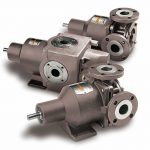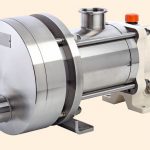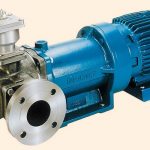Sealed pumps have been performing sufficiently in chemical manufacturing operations for many years. However, operators seeking a better alternative should look to upgrade their facilities with seal-less pumps. These pump types can reduce leakage events and improve the containment of dangerous or hazardous materials. Maintenance expenditure can also be reduced to such an extent that the lifetime costs for operating the seal-less pump may be only half those for a sealed model.
Safe handling of hazardous chemicals
Seal-less pumps offer full product containment
Sealed pumps have been performing sufficiently in chemical manufacturing operations for many years. However, operators seeking a better alternative should look to upgrade their facilities with seal-less pumps. These pump types can reduce leakage events and improve the containment of dangerous or hazardous materials. Maintenance expenditure can also be reduced to such an extent that the lifetime costs for operating the seal-less pump may be only half those for a sealed model.
To the average person, many of the raw materials commonly used in the manufacture of chemicals can resemble either a steaming bowl of alphabet soup – KOH, NaOH, HCl and HF, for example – or a bad Scrabble rack – toluene and xylene, monomers and polymers, for instance. However, those who make a living manufacturing know that valuable chemicals can simultaneously be extremely dangerous and harmful to site personnel and the environment alike if not handled properly. In addition to being widely used and potentially dangerous or hazardous if mishandled, many chemical compounds are also extremely expensive. If a leak were to occur during the handling or transfer of these products, high costs would be incurred by the operator, not only due to the loss of raw materials but also for clean-up and potential environmental remediation. All of these factors combine to make full containment of dangerous chemicals a front-of-mind concern for facility operators.
Four main areas of concern
Among the crucial items of equipment that are utilised during the manufacture and handling of dangerous chemicals are the pumps that either introduce raw materials into the production process or transfer end products for packaging, storage or shipping to end users. Mechanically sealed pumps are commonly used for these transfer activities, yet seal-less pump technologies can often be the more effective choice when full containment of dangerous and valuable chemicals is an absolute must. There are four main areas of concern for manufacturers when handling dangerous chemicals:
- Safety: Ensuring that site personnel, surrounding communities and the environment are not harmed
- Product containment: If dangerous or hazardous products are fully contained and not allowed to leak, valuable raw materials and products are not lost to the environment, improving safety overall
- Maintenance: Mechanical shaft-seal failures are the number one cause of pump downtime. Excessive maintenance costs are generally accumulated in two forms – the need to constantly repair, rebuild or replace underperforming pumps or components and the downtime that brings production runs to a grinding halt
- Operating costs: An overlooked drag on the bottom line can be seal-flush water, with the impact of the seal water on the process and the cost of the flush water needing to be taken into account
The most common pump technologies employed in the manufacture and handling of dangerous chemicals include diaphragm, sliding vane, lobe, progressive cavity, centrifugal and gear. All of the traditional pump technologies have one thing in common: they rely on various types of seals to prevent shaft leakage. The two most common types both have potential shortcomings. Packing rings utilise braided packing material that includes a set of formed rings which are wrapped around the pump shaft and held in place by an adjustable gland designed to control shaft leakage. A small amount of leakage is needed for lubrication and cooling.
Mechanical seals come in two basic variations: single and double. Single mechanical seals can address the problem of fluid leakage adequately in most cases but when used with liquids of higher viscosity, the product drag can distort the seal or cause it to break away from the shaft completely. Single mechanical seals are also incapable of containing potentially hazardous vapours. Double mechanical seals can prevent the escape of vapours and are more reliable when handling viscous liquids, yet they can be prohibitively expensive to acquire, repair, clean and maintain. While any of the various types of seals can perform for long periods of time, they will eventually require maintenance or need to be replaced before major shaft leakage can occur.
Achieving full containment
Seal-less sliding vane, internal gear and eccentric disc pumps are alternatives that can help eliminate some of the major concerns associated with achieving full containment. SMVP pumps, for example, combine Blackmer’s proven sliding vane pump technology with a seal-less magnetic coupling. The result is leak-free operation that minimises product waste and improves product yield. Constructed from corrosion-resistant stainless steel, SMVP pumps feature a magnetic coupling consisting of samarium-cobalt magnets and a unique bearing and head design that allows a small quantity of the pumpage to circulate through the containment can and onto the bearing surfaces. This positive flow of fluid minimises the temperature rise during operation, which in turn helps maximise the bearing life.
SMVP pumps additionally feature carbon-graphite sleeve bearings that help prevent metal-to-metal contact during operation. Replaceable 316 stainless steel end discs allow easy rebuilding of the pumping chamber to as-new condition without having to remove the pump from the piping. Other design benefits include volumetric consistency, self-priming and limited dry-run capability, drain plugs that permit easy draining and simple replacement of the vanes.
Internal gear pumps
Technological advances in internal gear pump design and operation have produced models that have only one fluid chamber. This method of construction does away with the adapter plate that is a staple feature of traditional, two-chamber, magnetically coupled, internal gear pumps, thus removing product entrapment concerns, especially when transferring high-viscosity liquids. Maag Industrial Pumps, part of PSG, a Dover company, offers Envirogear, a durable and environmentally friendly, positive displacement, seal-less gear pump. Envirogear uses magnets mounted directly to the rotor, eliminating the need for an adapter plate and allowing a single fluid chamber. This design results in a much shorter, simpler flow path and enables the pump to handle fluids with high viscosities up to 50,000 cSt easily while increasing the bearing life and cleaning capability.
The patented design supports the rotor and idler gears at three crucial locations with an eccentric spindle that is held in place at the head, the crescent and the back of the containment canister, eradicating many of the effects of cantilevered load. The larger diameter and harder materials provide more rigid support, with less shaft deflection and bearing wear. The materials are 4140 carbon steel or 17–4 PH stainless steel. Large, long radial bushings support the entire length of the rotating element, which distributes the hydraulic forces and helps the bushings last longer. The models are interchangeable with 95% of the internal gear pumps currently available in the market. That means no piping changes and no driver, coupling, flow rate or baseplate changes.
Eccentric disc pumps
Seal-less eccentric disc pump models manage without mechanical seals, packings, couplings and even magnets, with the shaft sealed instead by a unique, double stainless-steel bellows. The pumps can still offer self-priming, dry-run and low-shear operation, very high suction and discharge pressures, the ability to pump both low and high viscosity liquids and clean-in-place/sanitise-in-place (CIP/SIP) capability. Mouvex eccentric disc pumps – particularly the SLC, SLS and Micro C models – are ideal for optimising product recovery applications because of their ability to pump air, which creates a vacuum effect on the pump’s suction side and a compressor effect on the discharge side. This results in a plug effect that pushes a complete product plug out of the piping. Mouvex pumps can thus recover product from transfer lines at a rate of more than 90 % on the suction side and between 60 and 80 % or more on the discharge side.
www.cpp-net.com search: cpp0315psg
Chrishelle Rogers
Chrishelle Rogers
Global Gear Pump Product Manager, PSG
Nicholas Ortega
Nicholas Ortega
Engineering Manager, PSG
Share:









